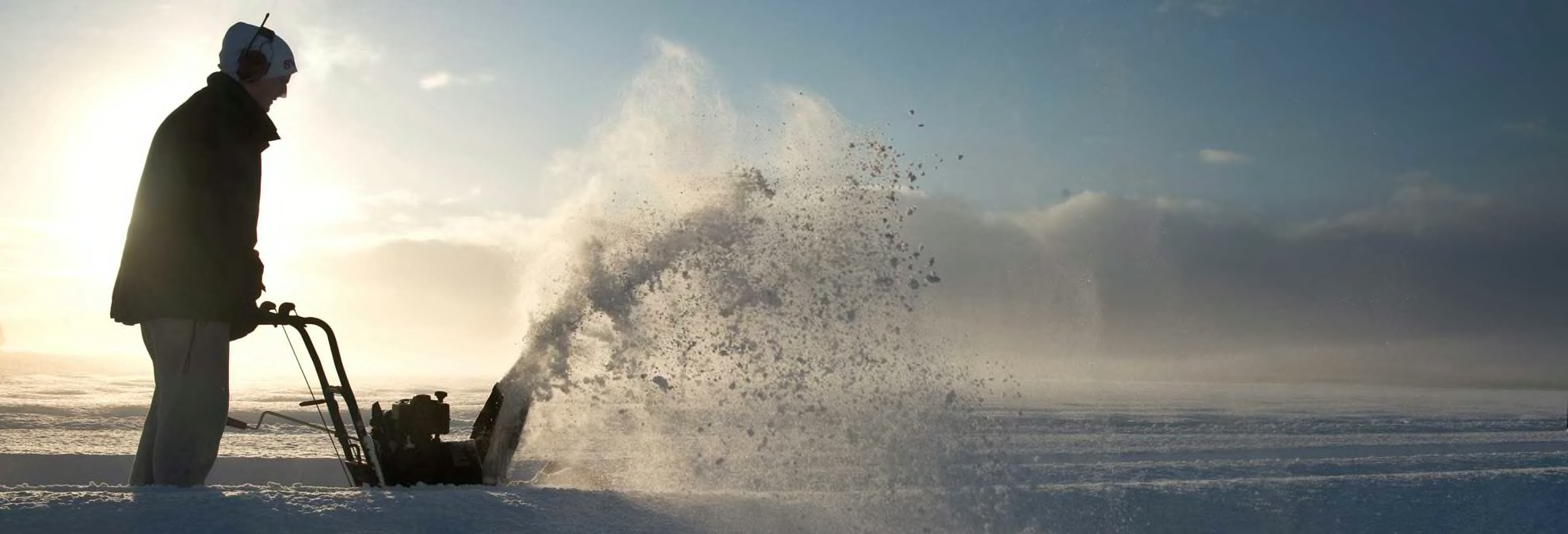
Snow Blower Buying Guide

Home & DIY Editor
A snow blower can be either a nice luxury or an absolute necessity, depending on how much snow you get in an average winter and how much real estate you have to clear.
If you have a short driveway and a garage attached to your house, you might get away with a decent snow shovel.
If you live in an area that rarely gets pummeled by winter storms, you might save time and money by hiring a plow truck once or twice a winter.
But if you get three or more big snowstorms a year and can’t afford to get trapped in your house while you wait for a plow service, a snow blower (also called a snow thrower) is definitely for you. It moves more snow than a shovel in a shorter period of time, clearing a wide pathway with each pass and shooting powder 20 feet or more out of the way—all without the back-breaking effort.
How to Choose the Right Snow Blower
The snow blowers in our ratings range in price from $200 to over $3,500. Features, size, and power account for this wide difference. Here’s what you need to consider when zeroing in on the kind of snow blower that will serve you best.
Single, Two, or Three Stages
In general, the more "stages" a snow blower has—which reveals the means used to collect and throw snow—the more power it packs. Two- and three-stage machines also tend to be wider than any single-stage model, with enough power to clear wider swaths in a single pass.
All snow blowers use an auger, which works like a drill in reverse, to suck up snow from the ground and discharge it through a chute. On single-stage snow blowers, the corkscrew-shaped auger is the only device moving the snow, automatically shooting it out the back but not throwing it as far as a larger machine. Single-stage machines rarely impress our testers. We recommend only a handful of models. They’re best for those who get a few inches of snow occasionally and have little to no risk of a major snowfall. Most of these tools will throw snow up to 25 feet, but work only on snow to a depth of 9 inches.
Two-stage models have an auger and an impeller, which is a fan that helps force snow collected from the back of the auger out through the discharge chute. As a result, these models collect snow faster and send it farther than single-stage blowers. Two-stage blowers typically throw snow up to 35 feet and can often clear it up to 16 inches deep.
Three-stage models have an auger and impeller, too, but they also add something called an accelerator, which helps force collected snow from the auger to the impeller. These machines can clear the fastest and throw the farthest, shooting snow 40 feet or more. Three-stage blowers can clear snow up to about 18 inches deep.
Gas, Corded Electric, or Battery
A vast majority of snow blowers have gasoline engines, and these models perform the best by throwing snow farther and clearing it faster.
Corded electric models can be used with an extension cord up to 100 feet from your house, but none perform well enough for us to recommend. They’re really best when supplementing a bigger tool. A plug-in electric is great for clearing a second-story deck or patio, or other spots where it would be tough to lug a bigger blower.
Battery-powered models are becoming increasingly popular. Among these, two-stage models tend to be more effective than single-stage units. Conveniently, some models also share batteries with other outdoor tools, like leaf blowers or string trimmers, that use lithium-ion batteries of the same voltage.
Wheels or Tracks
A majority of snow blowers are wheeled. For single-stage models, you push or pull it. On two-stage and three-stage machines, the wheels are powered by the engine, making those tools better for clearing large areas.
Some two- and three-stage snow blowers have tracks, like those on a tank, in place of wheels. They’re more suitable for hills and steep driveways because they boost traction significantly, but they tend to be more difficult to turn on level terrain.
How CR Tests Snow Blowers
It’s fascinating that no two snowflakes are alike, but that presents a problem for Consumer Reports’ testing protocol. For consistency, we run our tests with a mixture of sawdust saturated with water. This mixture can simulate a standard snowfall or be molded into a mound that simulates a plow pile, like the ones left at the foot of your driveway.
To test how well each model removes snow, we time how fast each blower cuts through the dense mixture and note how far the sawdust is thrown and how clean the surface is.
The Overall Score for each model combines results from these performance tests and our survey of tens of thousands of CR members, which inform our brand reliability and owner satisfaction ratings. Brand reliability reflects estimated problem rates by the fifth year of ownership. Owner satisfaction reflects the proportion of CR members who are extremely likely to recommend their machine to a friend or family member.
Types of Snow Blowers
We test six types of snow blowers: single-, two-, and three-stage gas snow blowers; single-stage and two-stage battery snow blowers; and single-stage electric snow blowers. We also include power snow shovels in our tests. Here’s an overview of what distinguishes each type of blower.
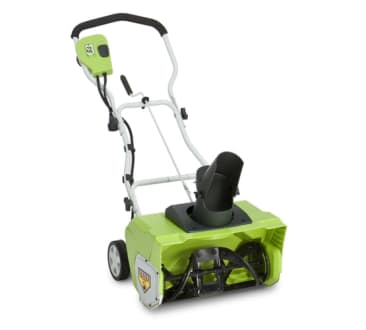
Single-Stage Electric Snow Blowers
Best for: Short, level driveways, decks, and walkways with snow levels of less than 6 inches.
About the size of a small walk-behind lawn mower, single-stage electric snow blowers are the lightest models to use, though you have to push them along yourself.
An electric motor frees you from fueling and engine maintenance, but a power cord can limit range and maneuverability. Working in swaths that are typically 21 inches wide or less, these machines may require more passes to clear a particular space than other types. And their modest power is no match for steep slopes.
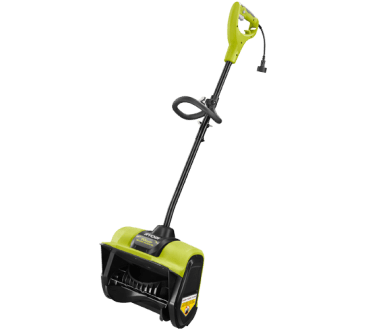
Power Snow Shovels
Best for: Short walkways or elevated decks with snow levels of less than 6 inches.
Smaller and lighter, power snow shovels are designed to go places where a snow blower would be overkill. They’re corded or battery-powered. We test them just like snow blowers, but we use far less of the sawdust mixture, because for anything deeper, you’ll want a traditional snow blower.
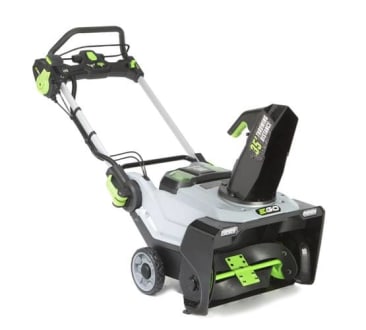
Single-Stage Battery Snow Blowers
Best for: Short, level driveways, decks, and walkways with snow levels of less than 6 inches.
Like plug-in electric snow blowers, battery-powered snow blowers trade performance for convenience. They start instantly and eliminate the need for gas, oil, or engine maintenance, but they just don’t pack as much power as gas models. They also have to be pushed along manually. Some can clear 9-inch-deep snow, but most max out at a depth of about 6 inches. That’s similar to a depth you’d easily tackle with a good snow shovel. They clear paths up to 21 inches wide with each pass.
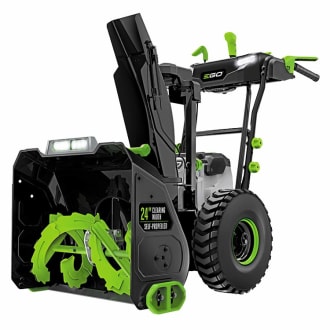
Two-Stage Battery Snow Blowers
Best for: Driveways, decks, and walkways with snow levels of less than 12 inches.
Two-stage battery blowers add an impeller to help the auger suck in snow more aggressively and shoot it farther than their single-stage counterparts. In our tests, that translates into more effective clearing and better throwing distances. And the best two-stage battery snow blowers can clear well, albeit not as fast as the best gas blowers. Most models max out at 24 inches wide and can clear depths of up to 16 inches, though they’re more effective at depths of 12 inches or less.
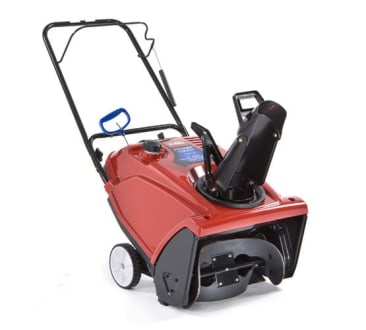
Single-Stage Gas Snow Blowers
Best for: Level, midsized paved driveways and walkways with expected snow levels of up to 9 inches.
These models tend to cost far less than large two-stage and three-stage gas machines. They’re fairly light and easy to handle, though they’re not self-propelled. They typically take up about as much storage space as a walk-behind mower. They clear swaths of up to about 22 inches wide, and some models offer an electric start.
Their gas engines are four-cycle, requiring only straight gasoline and no oil. But like electrics, they’re a poor choice for gravel driveways because they operate closer to the ground, sucking up stones in the process. Their auger provides only modest pulling power, and they tend to veer sideways on steep slopes.
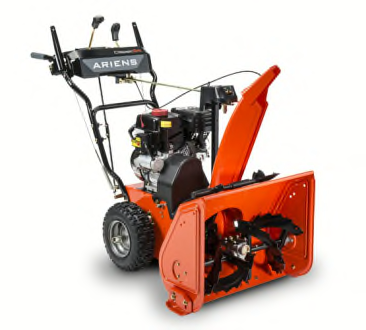
Two-Stage Gas Snow Blowers
Best for: Long, wide driveways with snow levels of up to 16 inches.
Two-stage snow blowers are best for clearing snow on gravel because the auger doesn’t touch the ground. Some models clear a swath up to 30 inches wide, and some can handle steeper inclines. The machines are heavier and cost more than with smaller models, and they can take up as much space as a lawn tractor, though you’ll also find easier-to-store compact 24-inch-wide models.
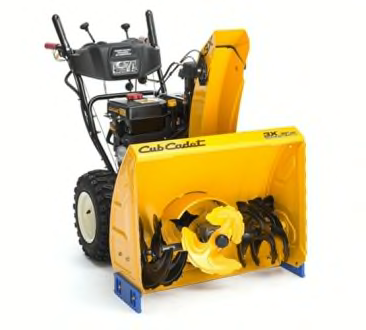
Three-Stage Gas Snow Blowers
Best for: Wide spaces with 18 inches or more of wet, heavy snow.
The machines are on the expensive side, they’re heavy, and they take up a lot of storage space in a garage or shed. Three-stage blowers can clear a 30-inch-wide swath of snow or more in some cases, but there are more compact options if you don’t have a particularly large space to clear.
Snow Blower Parts
Here’s where you’ll find the most crucial elements of your snow blower.
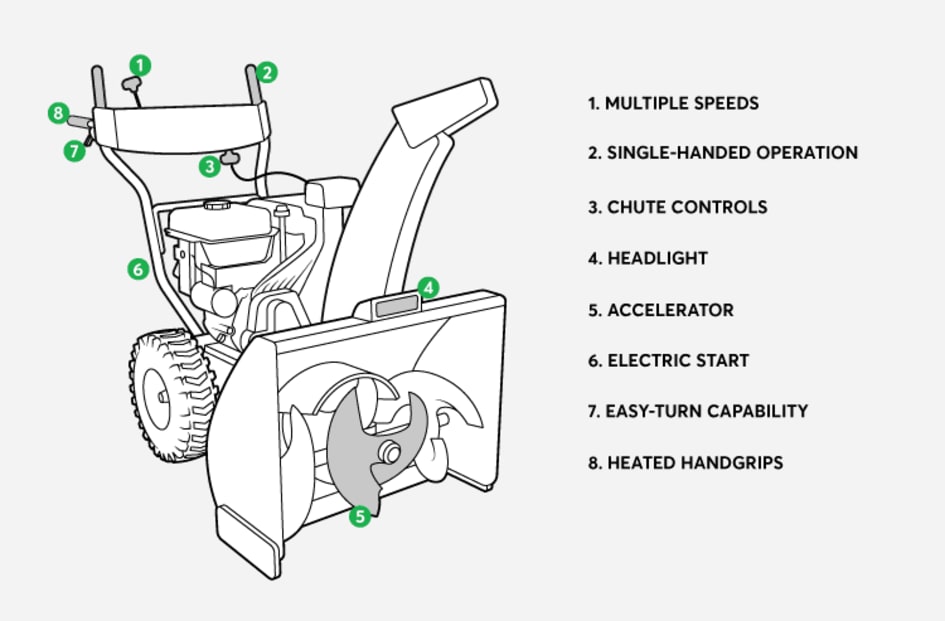
Illustration: Chris Philpot Illustration: Chris Philpot
Snow Blower Features to Consider
A good snow blower blends competent clearing ability with smooth, single-lever chute control that sends snow in any direction you want it to go. Retailers typically have floor samples you can check out. Be sure you’re comfortable with the height of the handle and with the chute adjustment controls, which you’ll be using frequently. Here are other important features to keep in mind.
- 1
- / 7
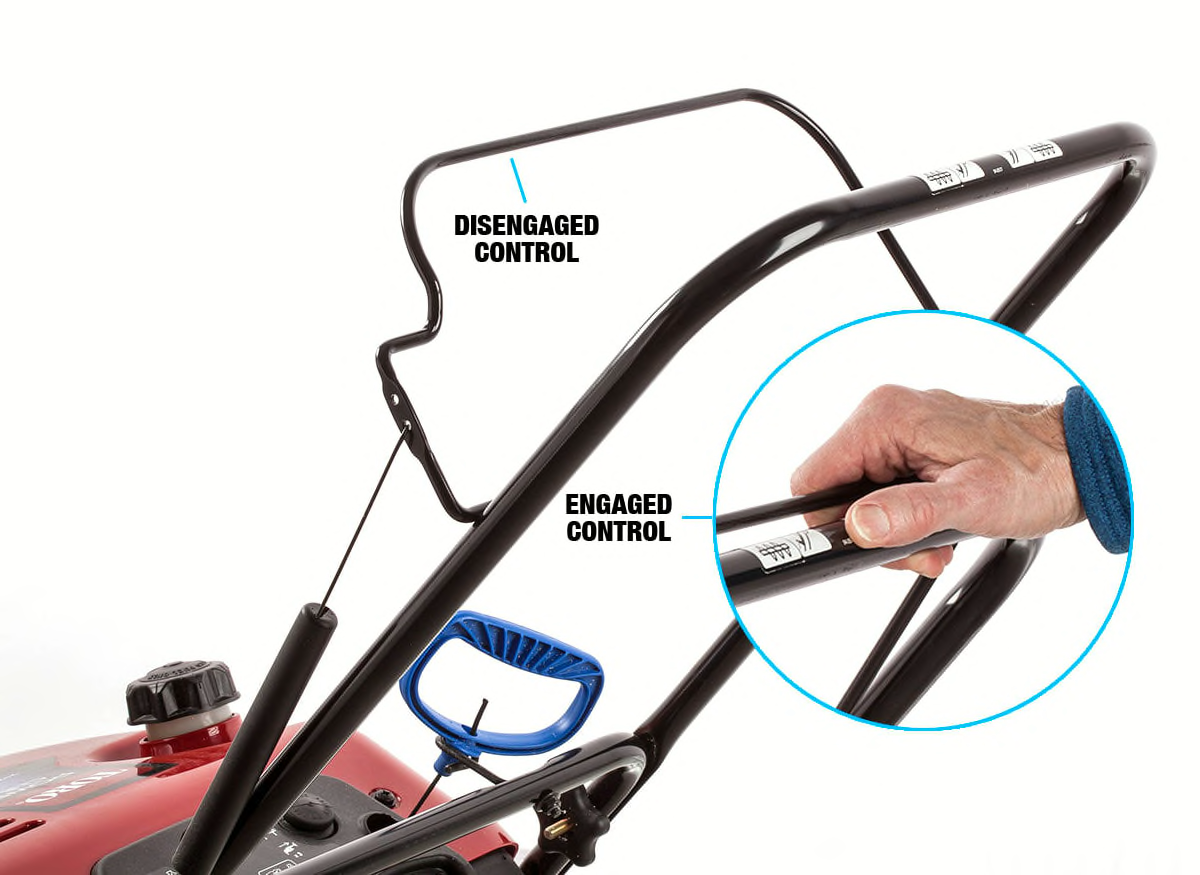
Dead Man’s Switch
All the snow blowers we tested have a dead man’s switch, a critical safety feature that stops the spinning auger and impeller when you release the handlebar grips.
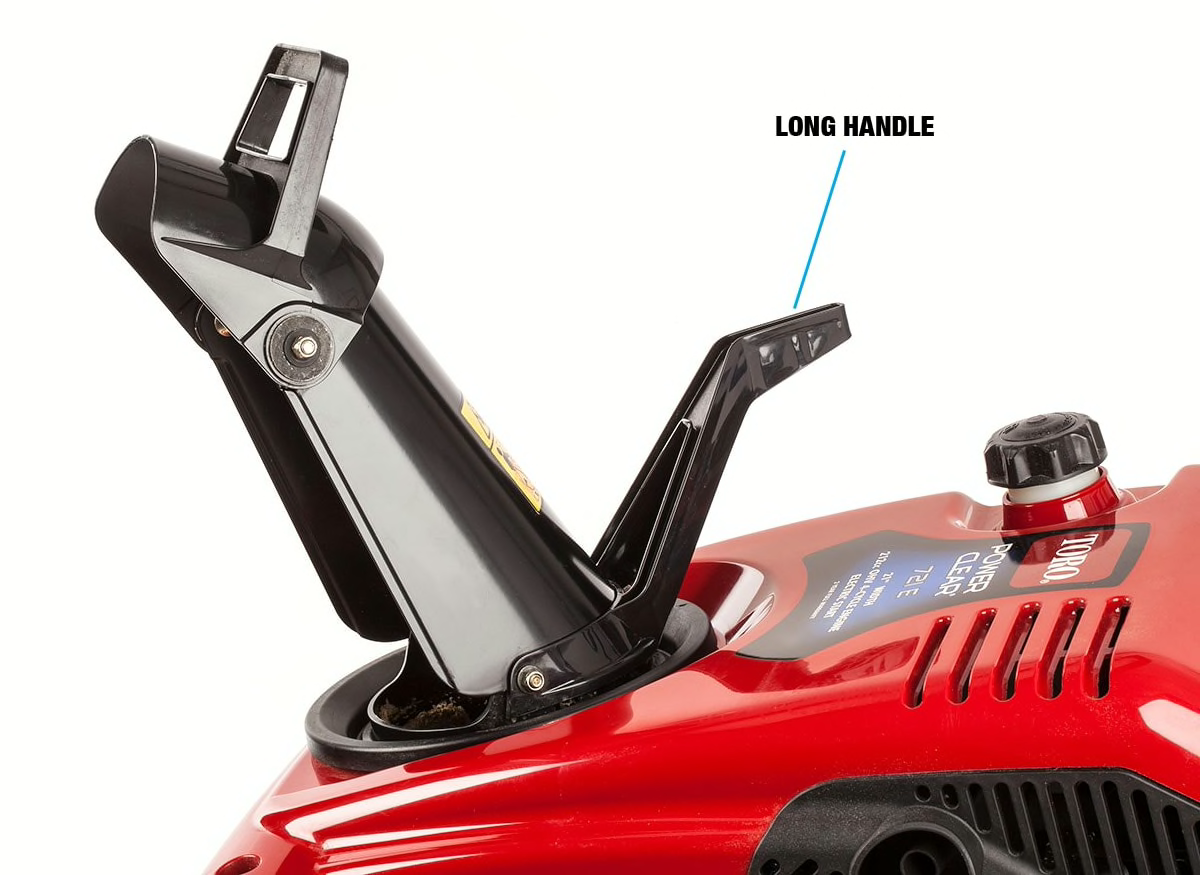
Long Handle
A longer handle on single-stage models lets you quickly change the height and direction of the snow thrown from the discharge chute.
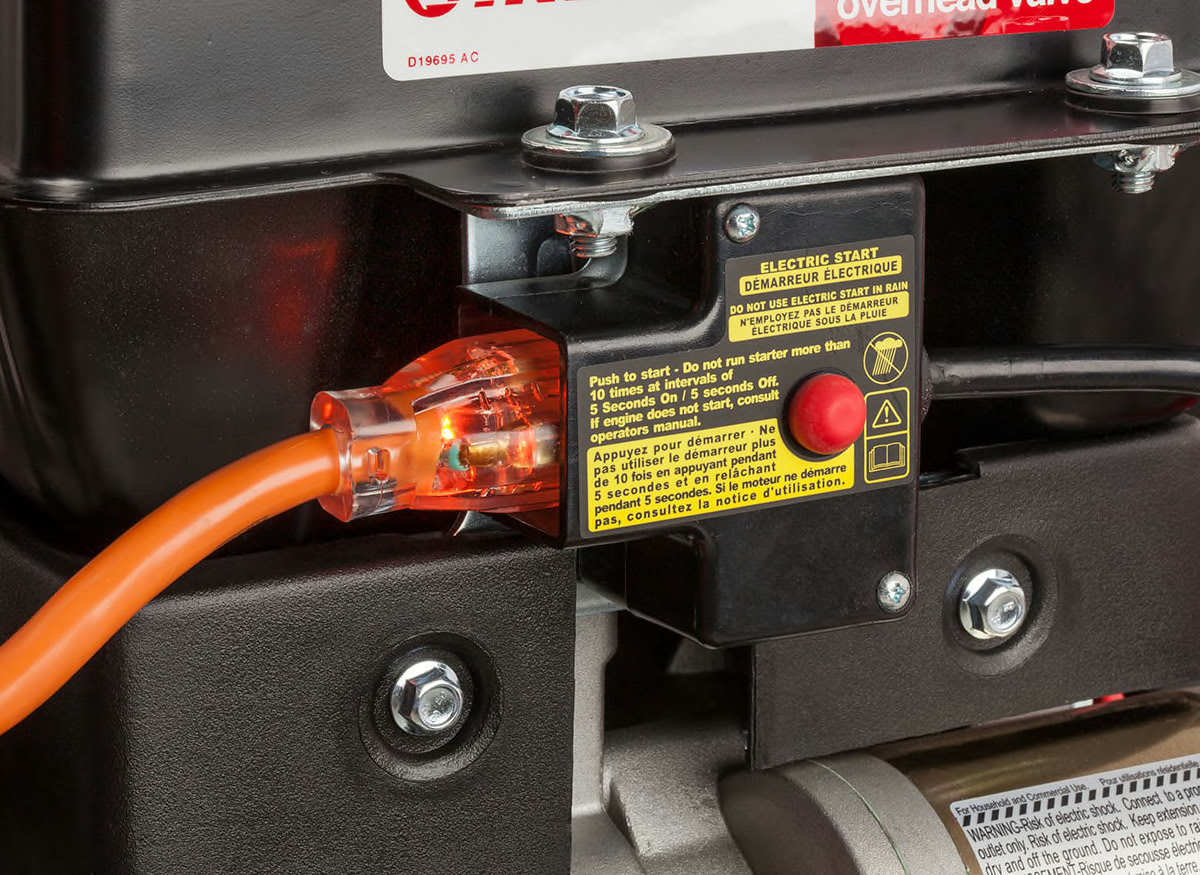
Electric Start
Most gas-powered models now offer plug-in electric starting, which is much easier than yanking a pull cord in cold weather. It also prolongs the life of the pull cord.
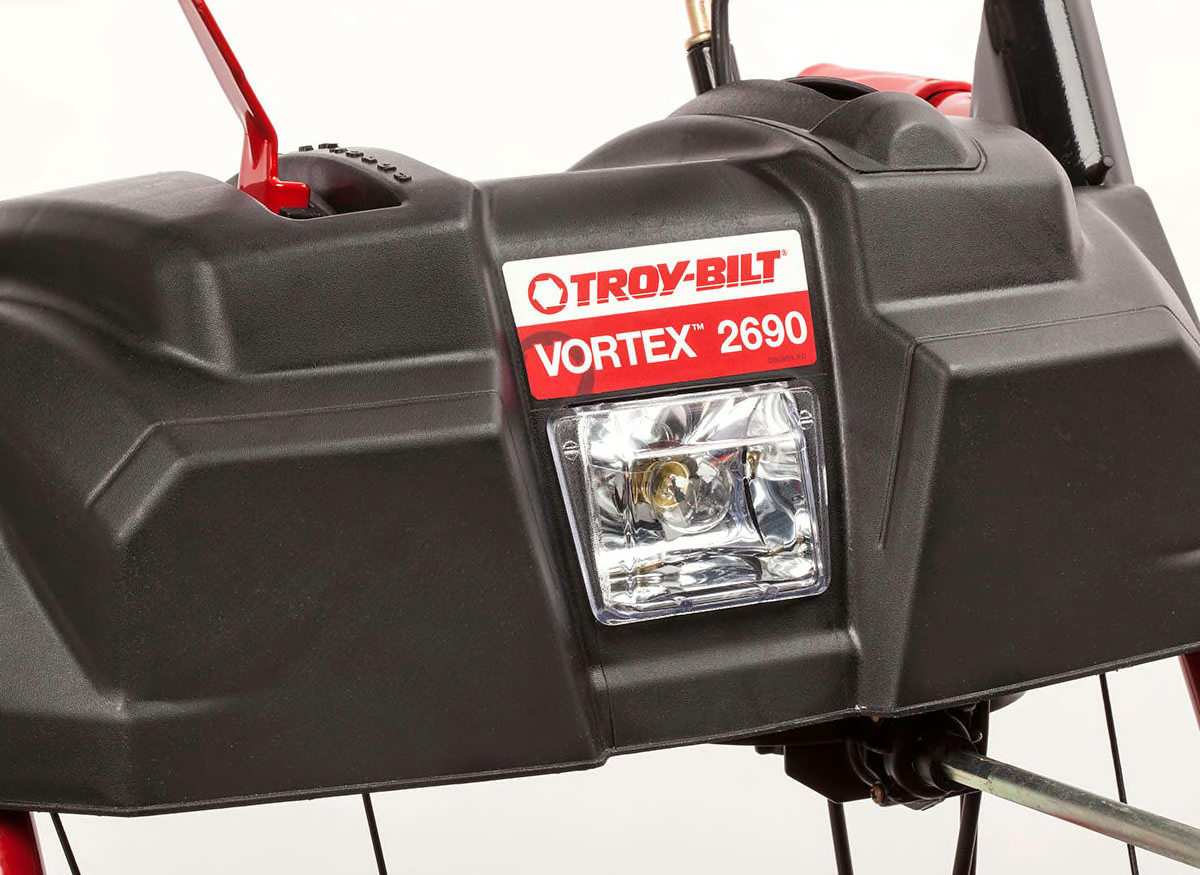
Headlight
This feature, present on many two- and three-stage machines, lets you work in the dark.
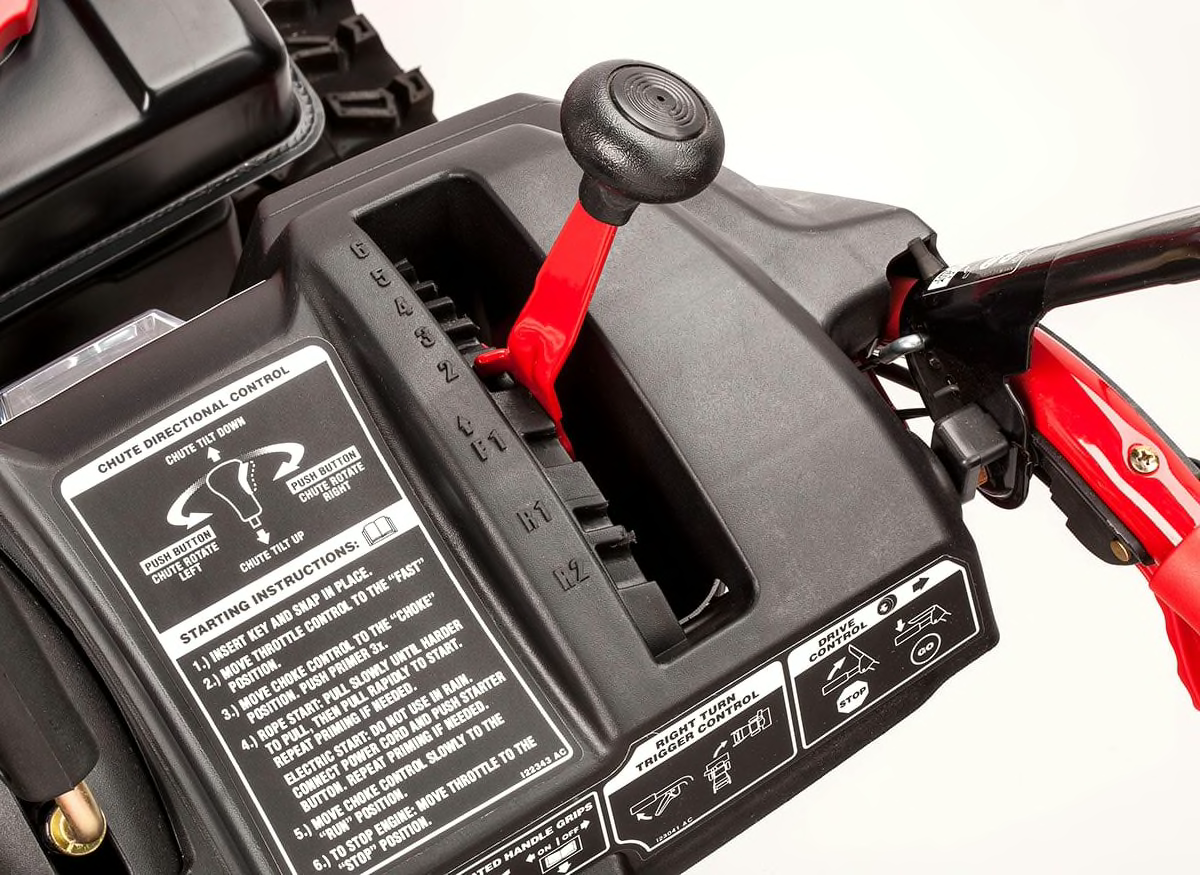
Multiple Speeds
Most multistage snow blowers have four to six forward speeds for the drive wheels—plus one or two reverse speeds. A choice of speeds can help prevent clogs while you slog through heavy snow.
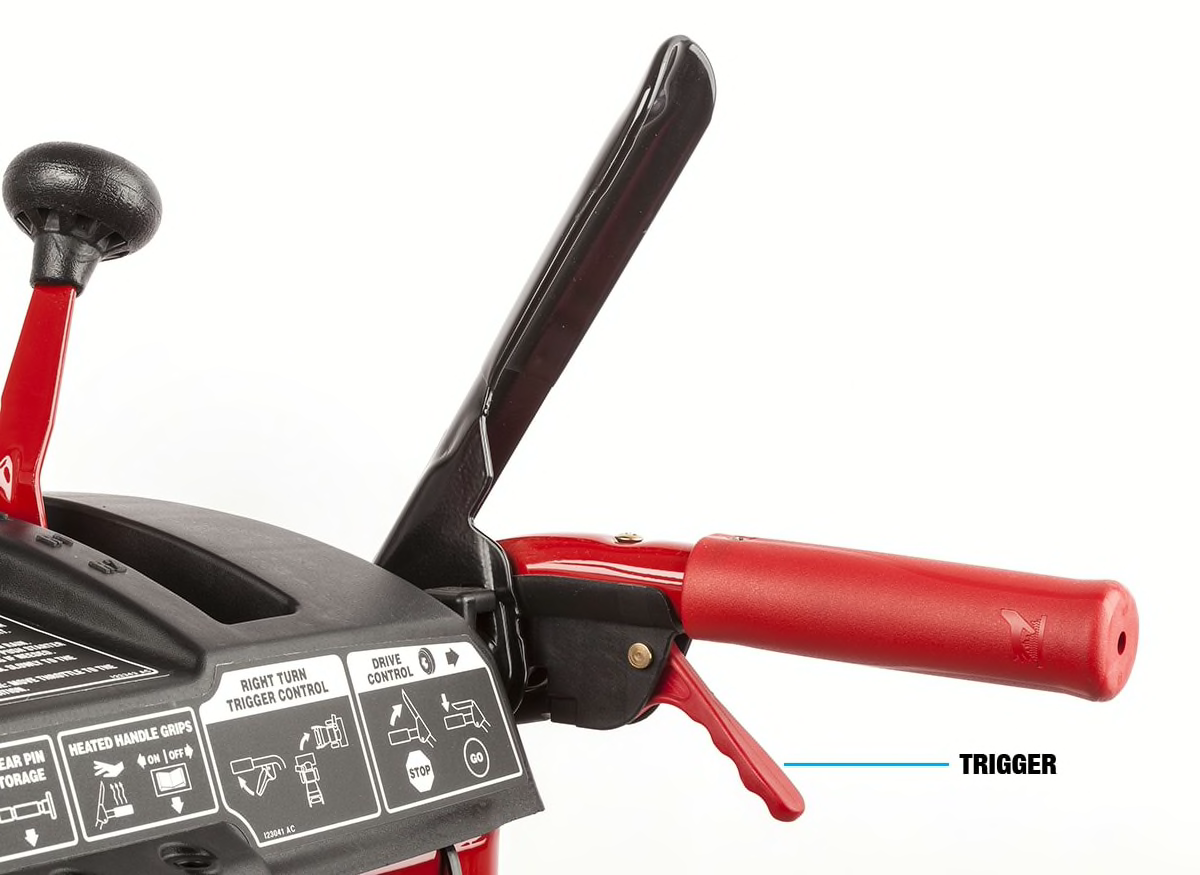
Trigger
A handlebar-mounted trigger release on multistage models eases steering by disengaging power to either or both drive wheels.
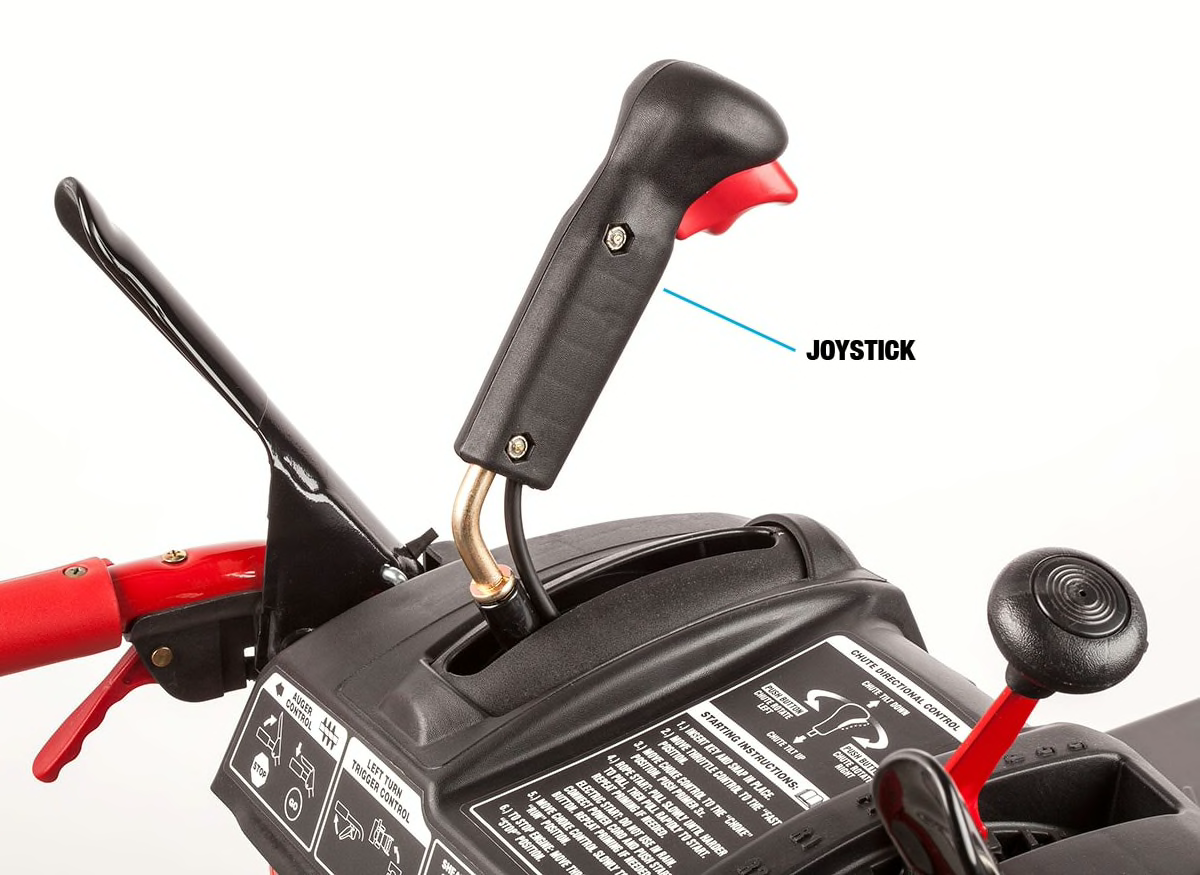
Discharge Shoot Control
Joystick chute controls let you change the vertical and horizontal direction of the discharge chute with the push of a lever. The lever can be a little difficult to maneuver if you’re wearing thick gloves.
Easy-turn crank controls might be a better option in frigid climates, though you should test the crank in a store to make sure it’s conveniently located (typically, adjacent to the handle).
Dead Man’s Switch
All the snow blowers we tested have a dead man’s switch, a critical safety feature that stops the spinning auger and impeller when you release the handlebar grips.
Long Handle
A longer handle on single-stage models lets you quickly change the height and direction of the snow thrown from the discharge chute.
Electric Start
Most gas-powered models now offer plug-in electric starting, which is much easier than yanking a pull cord in cold weather. It also prolongs the life of the pull cord.
Headlight
This feature, present on many two- and three-stage machines, lets you work in the dark.
Multiple Speeds
Most multistage snow blowers have four to six forward speeds for the drive wheels—plus one or two reverse speeds. A choice of speeds can help prevent clogs while you slog through heavy snow.
Trigger
A handlebar-mounted trigger release on multistage models eases steering by disengaging power to either or both drive wheels.
Discharge Shoot Control
Joystick chute controls let you change the vertical and horizontal direction of the discharge chute with the push of a lever. The lever can be a little difficult to maneuver if you’re wearing thick gloves.
Easy-turn crank controls might be a better option in frigid climates, though you should test the crank in a store to make sure it’s conveniently located (typically, adjacent to the handle).
Snow Blower Brands
Here are some of the names to know when you’re looking for a new snow blower.
Ariens snow blowers are available at outdoor power equipment dealers and Home Depot. It’s a leading brand whose model line consists of single- and two-stage gas options with snow-clearing widths of 18 to 30 inches.
Craftsman was traditionally the house brand at Sears, but now you’ll find its tools, including snow blowers, at Lowe’s. Craftsman sells single-, two-, and three-stage gas models with snow-clearing widths of 20 to 30-plus inches. The Craftsman Professional line features models with snow-clearing widths of up to 45 inches.
Cub Cadet is the first brand to introduce a three-stage snow blower and is still one of the largest manufacturers of machines of that type. It also makes single- and two-stage snow blowers, many of which are available at home centers and local dealers, with clearing widths of up to 30 inches.
Ego is a leading manufacturer of battery snow blowers, which are sold at Lowe’s and online retailers like Amazon. It makes both single- and two-stage battery snow blowers, as well as power snow shovels. The batteries can also be used in the brand’s other tools, like lawn mowers, leaf blowers, and string trimmers.
Greenworks is an electric tool brand that makes both corded and battery-powered models. It offers single- and two-stage snow blowers, as well as power snow shovels, and like most electric brands, its batteries can be used to power other outdoor tools from the same line.
Husqvarna is a premium Swedish brand that primarily makes gas-powered snow blowers. The bulk of its models are big—mostly full-sized two-stage blowers—and you’ll find them for sale online and at retail stores like Ace Hardware and Tractor Supply.
Snow Joe makes corded electric models and single- and two-stage battery snow blowers, as well as power snow shovels. Snow Joe models are sold online as well as at Home Depot and Lowe’s.
Toro sells a variety of electric, single-stage gas, and two-stage gas models at outdoor power equipment dealers and Home Depot. It also builds and sells electric models under the Power Curve and Power Shovel line names, and gas models under Power Shift, Power Max, Power Clear, and Snow Master brands. Electric models have snow-clearing widths of 12 to 18 inches, while gas models have widths of 18 to 30 inches. Toro also sells power snow shovels.
Models from Troy-Bilt, which has the same parent company as Cub Cadet, are largely sold at Lowe’s. It makes single- and two- and three-stage gasoline snow blowers with clearing widths from 21 to 45 inches.
What You Need to Keep Your Blower Running
Even a well-maintained snow blower can run into problems. Keep these extra items handy to ensure that your machine works when you need it most.
- Belts: These essential parts engage all the critical components of the blower. You’ll need one drive belt for single-stage machines and two for two-stage models.
- Shear pins: On two-stage models, they protect the engine and transmission by breaking if the auger hits something too hard. Keep extras on hand.
- Fuel stabilizer: If you run your snow blower every week, you won’t need this until you stow the unit in the spring. But when the machine sits idle, gasoline in the tank, fuel lines, and carburetor breaks down and thickens. Adding a stabilizer to your fuel can slow down this process.
How to Store Your Snow Blower in the Off-Season
If you store your snow blower properly, it remains in good working condition for the next winter storm. Here’s what to do at winter’s end.
- Store in a cool, dry location. We recommend stowing a snow blower in a spot that’s covered, dry, and shielded from temperature extremes. This is particularly important for battery-powered snow blowers, as heat and cold can degrade battery performance. If your snow blower must be stored outside, keep it elevated off the ground.
- Remove the fuel or battery. Prior to storing, drain any excess fuel or add fuel stabilizer. For cordless models, remove and store the battery in a cool, dry place.
- Consider a fitted, waterproof cover. This add-on can keep dust, dirt, moisture, and pests from getting inside.



























